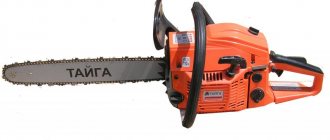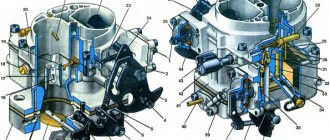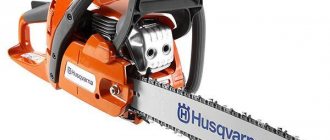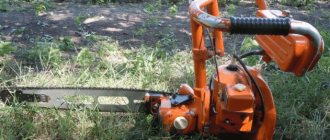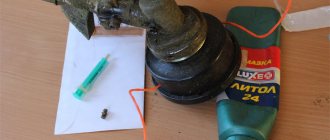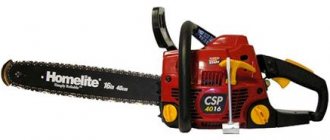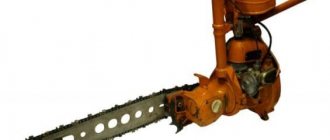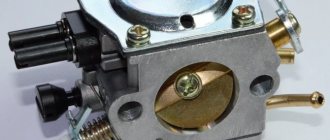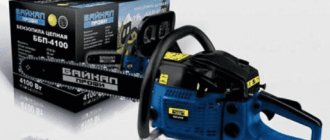Gasoline saws are used in the construction of log houses, logging, clearing areas of thickets, and replenishing the supply of firewood. They allow you to effectively work with wood. The relatively simple design of a chainsaw makes it a durable and reliable tool for both domestic use and professional work. Structurally, the product belongs to the category of machines equipped with an internal combustion engine (ICE). In many cases, this is a two-stroke single-cylinder engine. The user needs knowledge of the structure of the tool and the functioning features of its individual components - this will help to carry out maintenance correctly and, if necessary, carry out repairs independently.
How does a chainsaw work?
The design of a chainsaw is not too complicated. The main elements of its design:
- ignition system;
- carburetor;
- fuel system;
- air purification system.
Let's talk about each of them in more detail.
Ignition system
The ignition system of modern chainsaws contains elements that, depending on the speed of the saw, regulate the impulse. Most manufacturers today equip their equipment with electronic ignition instead of contact ignition.
The electronic ignition system consists of the following elements:
- magneto;
- candle;
- the electronic unit;
- wiring;
- motor start button.
Magneto is a type of alternating current generator. It supplies electrical energy to the spark plug. Any magneto consists of a coil with a core and high-voltage windings, a flywheel and a permanent magnet. Magneto can be contact or non-contact.
A contact magneto has two winding terminals. The first one goes to the spark plug, the second one goes to the ground. A capacitor can be connected to such a circuit to prevent the contacts from overheating and oxidizing.
In a contactless magneto, the voltage regulator is a coil. The thyristor, diode and capacitor regulate the amount of current. The electrical network operates in time with the translational movement of the cylinders and the rotation of the crankshaft. However, the connection diagram of all parts of the contactless magneto with each other depends on the model of the saw.
The ignition works like this:
- a magnet attached to the flywheel rotates with it and induces an electromotive force in the system;
- a current arises in the circuit, which is converted by an electronic unit into electrical signals;
- signals are transmitted to the candle;
- A spark is formed between the contacts of the spark plug, which ignites the fuel-air mixture.
In any ignition, a spark is formed when the engine piston does not reach its “dead center” by approximately 3-4 mm.
The spark plug consists of a body, an insulator and electrodes: central and side. By its condition, you can visually identify ignition faults.
After the fuel mixture ignites, the engine begins to operate. From time to time the entire ignition system needs to be adjusted.
Carburetor
On most chainsaw models, carburetors are designed the same.
They have a damper in the body. With its help, both screws (main and idle), diffuser, pulse channel and inlet fitting are adjusted. The damper also regulates the supply of atmospheric air.
Understanding how the carburetor works helps you adjust it correctly. It works like this:
- the engine starts, the air damper opens at the bottom of the housing;
- a vacuum occurs inside the float chamber and in the air channel because the piston moves;
- air is sucked in through the diffuser;
- the fuel mixture enters the float chamber from the gasoline tank through a fitting;
- in the diffuser, gasoline is mixed with air;
- Through the intake channels, the fuel-air mixture enters the combustion chamber.
Using the damper you can regulate the intensity of air entering the fuel, using screws you can adjust the engine speed, and using the jet you can adjust the speed of gasoline entering the diffuser.
Fuel system
Consists of a fuel filter, carburetor and manual fuel pump. However, not all chainsaws have a pump: in some models, gasoline from the tank enters the carburetor unit simply through a hose. The end of the hose with the fuel filter is immersed in gasoline, and gasoline stops flowing into the carburetor assembly when the tank is filled with air. To avoid this, a breather is attached to the tank cover: when it becomes dirty, the engine stalls.
The manual fuel pump allows you to fill the carburetor section with fuel in advance, so the engine starts faster.
Air purification system
Chainsaws are equipped with a preliminary and fine cleaning system so that the gas used to create the fuel-air mixture is of good quality.
The air is first filtered by a mesh filter, then fine filters.
Due to dirty filters, less air enters the carburetor assembly. As a result, the engine power decreases. To prevent this, filters must be constantly cleaned: blown or washed.
Starter
The starter starts the chainsaw motor. The starter mechanism consists of a handle, cable, drum and return spring.
If you sharply pull the handle with the torso, the drum will engage with the shaft, and the shaft will begin to rotate. The spring will help return the handle to its original position. In order for the rotation of the shaft to be followed by starting the motor, you will need to pull the handle more than once.
Chain
Chain pitch is the intermediate distance between three rivets located side by side.
The larger the chain pitch, the greater the engine power, its performance, and the effort required to increase the rotation of the drive sprocket.
But chains with a small pitch (more teeth and less distance between them) vibrate less, their movements are smoother when cutting, and the cut is cleaner.
Tire
Chainsaw bars vary in length. The length of the bar is the length of the working part, that is, the distance from the front of the saw to the rounded tip of the nose of the bar. As a rule, the length of the tire is indicated in the instructions.
But the reliability of the saw bar is determined not only by its own characteristics, but also by other details. For example, an asterisk. If the sprocket with replaceable ring is made of durable materials, the tire will last a long time. Thanks to the replaceable crown, the level of runout is reduced many times over.
In order for the tire to wear as evenly as possible, it needs to be turned over periodically, then its service life will increase.
Brake
If the chain accidentally touches the wood while rotating, a kickback occurs. In this case, for safety reasons, the brake must be applied.
The saw's braking system consists of a brake stop and a brake band. The system can be turned on in two ways: contact (the brake stop presses the worker’s hand) and inertial (when there is a sharp impact on the tire, inertial forces arise that act on the brake).
Chain lubrication system
In modern chainsaws, the chain and bar are automatically lubricated. At idle, there is no oil supply, since the oil pumps begin to work only after the sprocket rotates and the gear train starts moving. The higher the sprocket revolutions, the more oil flows from the pump to the chain. The pump is installed on the chain side and receives oil from the oil tank through an oil line.
Adjusting chain tension
Loose guide bar.
Before each use of the chainsaw, service the chain. Check the chain tension 10 minutes after starting it and periodically during operation.
The chain usually sag when it gets hot.
Loose guide bar.
Turn off and disconnect the spark plug cable. While wearing work gloves, carefully pull the chain along the guide bar; it should slide smoothly and stay in the groove.
- Chain is tight or moves - too tight
- chain slips out of groove - too loose
To adjust the chain tension, loosen the bar nuts using the socket wrench included with the chainsaw.
Locate the tension screw on the guide bar, usually on the side opposite or between the mounting nuts as shown. Tilt the chainsaw slightly to lift the toe of the guide bar and use a screwdriver to turn the tension screw.
Reset the tension screw.
Turn clockwise to tighten or counterclockwise to loosen the chain. Reset the tension screw so that the chain slides smoothly along the guide bar without slipping out of the groove. There should be only slight slack in the chain along the bottom of the guide bar. Tighten the tire nuts and check the chain tension and readjust if necessary. Reconnect the spark plug cable.
Loosen the chain before storing the chainsaw.
How to use a chainsaw
Using a chainsaw correctly is important to avoid injury hazards. The best information about the rules of operation of a chainsaw is stated in the instructions for it. The main thing is to hold the instrument firmly with both hands and all fingers.
How to start a chainsaw correctly
Before starting the chain saw, you need to engage the chain brake and remove the bar guard.
After this do the following:
- press the decompression valve control button, if equipped;
- activate the mode switch lever
- put the saw on the ground, pressing the rear handle with your right foot and grasping the front handle with your left hand;
- pull the starter handle until the engine starts;
- press the mode switch lever and press it until the saw starts working;
- Increase idle speed and release chain brake.
How to cut with a chainsaw correctly
To operate a chainsaw correctly, you need to follow the basic recommendations:
- Keeping the saw close to your body will help maintain balance.
- Spread your legs wide apart and bend your knees.
- Keep your back straight.
- Before moving to a new location, you need to turn off the engine by activating the brake.
Disposable overalls will help protect against accidental cuts. You should wear a protective helmet with a mask on your head, thick gloves for your hands, a padded suit for your body, and sturdy shoes for your feet.
Maintenance of the electronic ignition module (EMM)
Gap and replacement of the electronic ignition module (EMM).
Turn off the chain saw and disconnect the spark plug cable, then drain the fuel tank. Remove the starter housing and identify the EMC.
Gap and replacement of the electronic ignition module (EMM).
For the EMG gap, use a brass or plastic feeler gauge that matches the gap specified by the manufacturer. Rotate the flywheel until its magnets are as far away from the EMZ as possible. Loosen the screws and move the EMC enough to position the dipstick horizontally between it and the flywheel (far left). Rotate the flywheel until its magnets align with the EMZ. Tighten the EMZ screws and pull out the dipstick. Reinstall the starter housing assembly, prime the chainsaw, and reconnect the spark plug cable. If the problem persists, replace the EMC and spark plug cable.
Replacing the electronic ignition module.
To replace the EMC cable and spark plug, also remove the air filter and engine housing. Use long nose pliers to remove the ignition wire from the EMC, then slide it out of the sheath while holding it against the spark plug cable. Unscrew the EMZ and remove it. Install an exact duplicate of the EMZ, connect the ignition wire and reinstall the engine housing and air filter.
Price up to 10,000 rubles
In this price range, Chinese chainsaws are most widely represented. Among the first in the popularity rating among compatriots:
- FGS 45-45 from Forte with a good anti-vibration system, the ability to work in any position and cut medium-sized logs. She has:
- engine volume - 45 cm³, power - 2.4 kW;
- 45 cm tire;
- cost - from 2.3 thousand rubles.
- Foreman Professional with power unit power increased to 2.8 kW. The latter has air cooling, which prevents overheating of the chainsaw during continuous and long-term operation. The unit is equipped with a Japanese Walbro carburetor, which increases the durability of the product. The model costs from 2.7 thousand rubles.
- Rostec BP-52 Professional. You can buy it for 1.85 thousand rubles, although the unit is equipped with a powerful (3 kW) motor and can be used for felling timber and for construction work. Is different:
- a body made of impact-resistant plastic;
quick start;
- ease of use;
- availability of hand protection;
- internal chrome plating of cylinders;
- ability to work in different positions.
- GoodLuck, positioned by the manufacturer as professional. Chainsaw:
- with low gasoline consumption;
- with protection for the worker’s hands;
- with a 2.8-kilowatt engine with a cooling system;
- with a weight of 5 kg;
- with easy maintenance;
- with a price starting from 2.75 thousand rubles.
- GreenTec, which has the Russian marking BC-0112 and is offered for sale for a price starting from 3.2 thousand rubles. It has the ability to regulate idle speed and fuel mixture supply. Equipped with:
- tire 45 cm long;
- medium (1.8 kW) power engine with a volume of 45 cm³;
- fuel and oil tanks with a capacity of 600 and 400 ml, respectively.
In the price range of 5-7 thousand rubles, Chinese manufacturers offer chainsaws:
- Titan BBCP 25-25. It is portable, with a yellow body, 18 and 20 inch tire made of special steel, imported (Steele) chain, carburetor with a 5-year warranty. Supplied with a set of spare parts. Costs from 8 thousand rubles.
- Storm WT-0645. The model is compact, semi-professional. It has:
- improved characteristics;
- 2.4-kilowatt power unit with a volume of 56.5 cm³;
- gasoline tank (AI 92) with a volume of 550 ml;
- manual start;
- automatic lubrication of the saw set;
- emergency stop protection;
- tire 45 cm long.
Currently reading: Chainsaw Hooter BS 52 characteristics
Brands of Chinese-made chainsaws in the price range of 7-10 thousand rubles are represented insignificantly. Basically these are the best fakes of branded models. Among these is the Alpina A 3700, which costs from 9.4 thousand rubles. The chainsaw is similar to the Japanese Komatsu-Zenoah G3700, which is a good recommendation for it.
The unit has an Oregon tire, which indicates the reliability of the headset. But the plastic that protects it is of low quality. The tire size is 35 cm, the chain has a tooth pitch of 3/8″. This is enough for simple household work.
The chainsaw is supplied with:
- 2-stroke engine with a volume of slightly less than 40 cm³ and a power of 1.6 liters. pp., low consumption of gasoline and oil;
- hard plastic handle;
- average vibration protection;
- small (300 ml) gas tank;
- reliable chain brake.
The disadvantages of the model:
- the carburetor is often not adjusted correctly;
- an unsuccessful casing under which sawdust constantly collects.
Chinese chain saw STIHL MS 660
So far the new one is working great.
For starting mode, so that the parts are sufficiently lubricated, the Husqvarna chain carburetor setting is made so that the maximum speed is 600-700 rpm. below working. If it is not possible to set the operating maximum frequency on the tachometer, there is no need to change the preset using screw H.
For precise adjustment, the saw must be heated for at least 10 minutes and placed on a flat surface. The tire should be pointed in the opposite direction from the person doing the adjustment. At the initial stage, the highest idle speed should be detected. To do this, screw L and smoothly turn first left and right, and then vice versa.
The idle speed is controlled by the jet, indicated by the letter T. It should turn from left to right until the chain begins to move. Then feed smoothly in the opposite direction until the chain stops rotating. Screw H is considered to be installed correctly if the noise of the saw running at full throttle without load remains small.
Fuel supply system repair
Fuel may not enter the cylinder for the following reasons:
- Fuel filter is dirty. You should remove the fuel hose and check how the fuel flows. If the stream is weak, the filter may need to be cleaned. It is taken out through the filler hole of the fuel tank and cleaned; in case of severe contamination, it is replaced with a new one. As a preventative measure, it is recommended to replace the fuel filter once every three months.
- Clogged breather (hole in the fuel tank cap). They also check by disconnecting the hose; if clogged, clean it with a needle.
- Lack or insufficient fuel. There may be several reasons for the malfunction. The first reason is a clogged air filter. Air stops flowing into the carburetor in the required quantity, and therefore, due to the fuel mixture being too rich, engine operation is disrupted. The dirty filter is carefully removed, cleaned and rinsed in water, then dried and replaced.
Another reason is incorrect carburetor adjustment. Adjustment is made with three screws.
Timely replacement of the fuel filter guarantees a complete fuel supply
The fuel hose and choke actuator must fit tightly to the fittings
The throttle cable must be in place.
During work, you must use the instructions, otherwise you can only make things worse.
And the last reason is a violation of the integrity of the membrane or clogging of the carburetor channels.
To repair a carburetor yourself, you need to become familiar with all its parts.
All parts must be clean, dry and in good working order.
